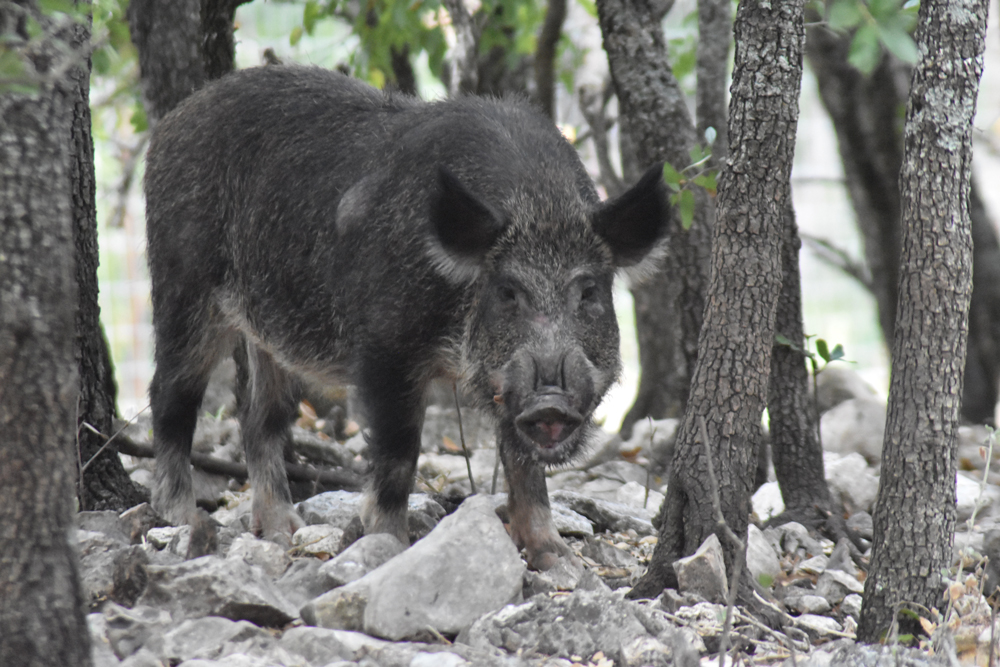The hogs approve this message.
Wild hogs are exceptionally hard to kill. They can leap over fences and run 30 miles per hour on open ground, making them difficult to shoot. And they’re smart, learning to avoid traps if other members of their group have been captured.
But after three decades of watching their population numbers explode across Texas and other parts of the United States, state and federal officials believe a solution might be in sight.
Six years ago, the U.S. Department of Agriculture launched a pilot program utilizing helicopters and specially designed traps to slow the spread of wild hogs. Now a bipartisan group of senators, including U.S. Sen. John Cornyn, are pushing to take the program nationwide.
Individual farmers and state agencies have employed similar techniques for years to try and control the pigs, but not with the level of coordination and spending the federal government has brought, said John Tomecek, a wildlife professor at Texas A&M University, who conducted an assessment of the program.
“You’re trying to establish a front and move the pigs back, and in the areas where the program has been employed we’ve seen the effectiveness,” he said. “The dream is one day we push them back far enough one day they’re not a problem anymore.”
While the impact of the program is still being studied, Tomecek said in those areas where the pilot program is operating, farmers are reporting a significant increase in crop revenue, a sign the government’s methods to control the local population are working.
At a time President Donald Trump and Republicans are looking to cut federal spending, getting agreement on $75 million in new funding could prove a tough sell in Congress. But Cornyn said he was confident the support was there given the billions of dollars a year in damages the hogs cause to farms and other businesses across the country.
“The last time I checked the federal government spends about $6.7 trillion a year so this is not a big issue from that standpoint,” he said. “Given the challenges our agriculture sector has faced, it seems to me like an important thing to do.”
The U.S. Department of Agriculture, led by Secretary Brooke Rollins — another Texan — declined to comment on whether it supported extending the program.
[…]
After years of watching farmers struggle to control the pig populations themselves, Congress authorized the Feral Swine Eradication and Control Pilot Program in 2018. It initially launched in select counties across eight states, including 16 counties in Texas, where the program has quickly won over farmers.
The strategy is to kill as many hogs within a given group at once, so as to limit the population’s ability to learn and evade capture. In grasslands, sharpshooters ride in specially-designed helicopters than fly at the same speed as the hogs run. And in wooded areas like East Texas, 20-foot wide traps capable of capturing up to 50 hogs at a time are used.
“They do it day in and day out, and they’re very effective at it,” said Tracy Tomascik, associate director at the Texas Farm Bureau. “For a farmer to do this on his own would be very expensive, but when you spread the cost around it’s not so bad.”
However, it’s unclear whether, what to date has been a relatively small program, would work at a larger scale.
I have of course written about feral hogs many times. I don’t recall this particular program offhand – it usually seems like it’s the Lege, or occasionally a county government, trying things to slow them down – but every little bit is needed, and this seems to have some promise, though with limitations. The “shoot them from the sky” approach is well known, mostly from helicopters but also from hot air balloons. That has always had some limitations, for obvious reasons. More recently, a toxicant called warfarin has shown some promise.
So even without this federal effort, there will be ways to try to control the hog population. I don’t know how much difference this one thing would make, but it’s surely fair to say that anything reasonably viable needs to be on the table, and Senator Cornyn is correct that the amount of money being spent is barely even a rounding error in context. That doesn’t mean anything to the DOGEbags, and the fact that the Ag Secretary couldn’t be bothered to comment doesn’t bode well. And as to the fate of this funding in the so-called Big Beautiful Bill, who knows. The hogs themselves are probably not worried.

